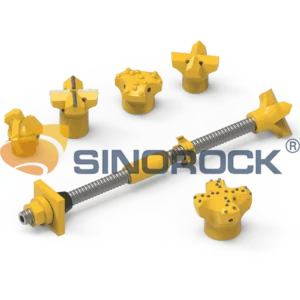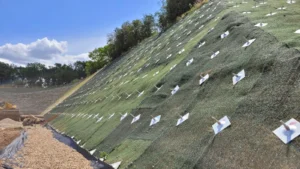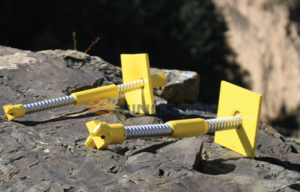Slopes are an integral part of our natural and built environments, playing crucial roles in landscape formation, infrastructure development, and environmental stability. Proper understanding and management of slopes are essential to prevent geological hazards, ensure the safety of infrastructure, and maintain ecological balance. This article delves into the various types of slopes, methods of slope stabilization, and techniques for reinforcing slopes to mitigate risks and enhance stability.
Types of Slopes
Slopes can be classified based on various criteria, including their origin, composition, height, inclination, and stability. Understanding these classifications is fundamental for geotechnical engineers, environmental scientists, and construction professionals.
Classification by Origin
- Natural Slopes: These are formed by natural geological processes such as erosion, weathering, and tectonic activities. Examples include hillsides, cliffs, and riverbanks.
- Man-made Slopes: These are created by human activities, including construction, mining, and excavation. Examples include road cuts, embankments, and terraced landscapes.
Classification by Composition
- Soil Slopes: Composed primarily of loose or cohesive soils, these slopes are more susceptible to erosion and landslides. Soil slopes are common in agricultural areas, riverbanks, and construction sites.
- Rock Slopes: These consist of solid rock formations and are generally more stable than soil slopes. However, rock slopes can still be prone to rockfalls and structural failures due to weathering, seismic activity, or human intervention.
Classification by Height
- Low Slopes: Soil slopes less than 5 meters in height and rock slopes less than 8 meters. These slopes are relatively stable but still require monitoring for potential issues.
- Medium-high Slopes: Soil slopes ranging from 5 to 10 meters and rock slopes from 8 to 15 meters. These slopes may require stabilization measures to prevent failures.
- High Slopes: Soil slopes between 10 and 15 meters and rock slopes from 15 to 30 meters. These slopes often need extensive engineering solutions to ensure stability.
- Ultra-high Slopes: Soil slopes exceeding 15 meters and rock slopes over 30 meters. These slopes present significant engineering challenges and require advanced stabilization techniques.
Classification by Inclination
- Gentle Slopes: Inclinations less than 15°. These slopes are typically stable but can become problematic under certain conditions, such as heavy rainfall or human activity.
- Medium Slopes: Inclinations between 15° and 30°. These slopes may require some form of stabilization to prevent erosion and landslides.
- Steep Slopes: Inclinations between 30° and 60°. These slopes are prone to instability and often need significant engineering interventions to ensure safety.
- Sharp Slopes: Inclinations between 60° and 90°. These are highly unstable slopes that require specialized techniques for stabilization.
- Reverse Slopes: Slopes that incline backward, often seen in mountainous regions. These slopes are challenging to stabilize and pose significant risks.
Classification by Stability
- Stable Slopes: Slopes that remain in equilibrium under existing environmental and loading conditions. These slopes do not show signs of movement or failure.
- Unstable or Critical Stability Slopes: Slopes that are on the verge of failure. These slopes require immediate attention and stabilization to prevent catastrophic events.
- Destabilized Slopes: Slopes that have already failed or are in the process of failing. These slopes need urgent remedial measures to restore stability.
Slope Stabilization
Slope stabilization is essential to prevent slope failures, protect infrastructure, and ensure public safety. Various methods are employed to stabilize slopes, each tailored to the specific conditions and requirements of the site.

Anchors
Anchors are widely used in slope stabilization to provide additional support and prevent soil or rock movement. These can be either passive or active anchors.
- Passive Anchors: These anchors rely on the weight of the slope to provide stability. They are often used in conjunction with other stabilization techniques, such as retaining walls or soil nails.
- Active Anchors: These anchors are pre-stressed to provide immediate support to the slope. They are particularly effective in stabilizing steep or highly unstable slopes.
Foundation for Avalanche Protection
In regions prone to avalanches, constructing foundations specifically designed to withstand avalanche forces is crucial. These foundations help prevent snow and debris from sliding down slopes, protecting infrastructure and human lives.
- Avalanche Barriers: Structures built to intercept and slow down avalanches, reducing their impact on vulnerable areas.
- Snow Sheds: Tunnel-like structures that allow avalanches to pass over roads or railways without causing damage.
- Retaining Walls: Walls constructed to hold back snow and debris, preventing them from reaching critical infrastructure.
Ground Anchors in Foundation Pit Support
Ground anchors are used to provide pre-stressing support during foundation pit excavation, ensuring the safety and stability of the excavation site.
- Temporary Anchors: Installed during the excavation process and removed once the foundation is complete.
- Permanent Anchors: Remain in place after construction to provide ongoing support and stability.
Retaining Wall Reinforcement
Retaining walls are essential for maintaining the stability of slopes and preventing soil erosion. Reinforcing these walls enhances their load-bearing capacity and ensures long-term stability.
- Gravity Walls: Relies on their weight to resist pressure from the slope. Reinforcement can involve adding additional weight or using geogrids for added stability.
- Cantilever Walls: Use leverage to hold back soil. Reinforcement includes using stronger materials or adding counterforts for additional support.
- Sheet Pile Walls: Made of steel, concrete, or wood, these walls are driven into the ground to provide support. Reinforcement can involve extending the piles deeper into the ground or using tie-backs for added strength.
Embankment Stabilization
Embankment slopes below road surfaces require reinforcement to prevent collapse and ensure road safety.
- Geotextiles: Synthetic fabrics used to reinforce soil and improve stability. They are commonly used in road embankments to prevent erosion and increase load-bearing capacity.
- Gabions: Wire mesh containers filled with rocks, used to stabilize slopes and prevent erosion.
- Vegetative Solutions: Planting vegetation on slopes to provide natural reinforcement through root systems.
Cutting Reinforcement
Cut slopes, or rift valley slopes, are higher than the road surface and require reinforcement to prevent collapse and ensure the safety of the road.
- Soil Nailing: Involves inserting steel bars into the slope to provide additional support. This technique is particularly effective for steep slopes.
- Shotcrete: Spraying concrete onto the slope surface to provide immediate stabilization. This method is often used in combination with other reinforcement techniques.
- Terracing: Creating stepped levels on the slope to reduce the load on each level and prevent erosion.
Conclusion
Understanding the different types of slopes and the various methods of stabilization and reinforcement is crucial for ensuring the safety and stability of natural and man-made slopes. By employing appropriate techniques and technologies, we can mitigate the risks associated with slope failures, protect infrastructure, and preserve the environment. Whether dealing with gentle slopes or ultra-high, sharp inclinations, the principles of slope management remain the same: assess the conditions, apply the right solutions, and continually monitor and maintain stability.





